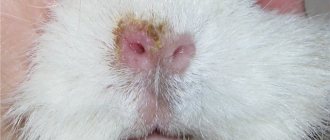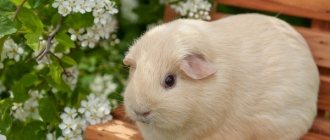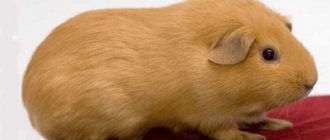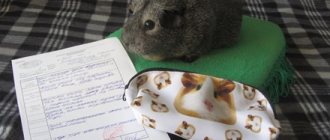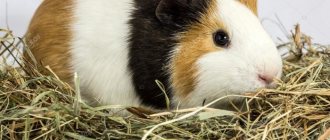Just 20 years ago, not all parents had the opportunity to give their child a dream - a puppy or a kitten. And this is not surprising - such animals had to be walked with, they required a lot of attention, and animals that could be kept in a cage were, in general, very rare on the open market. Modern children are luckier. Many hobbyists breed and sell various small animals. For example, breeding guinea pigs as a business has become a very popular idea. Moreover, children really like these funny animals, and this, you see, is a good reason to become interested in this business idea. Therefore, now we will talk about how to implement it and start earning good money.
Is it necessary to divorce?
It is important to approach the business of breeding animals with all responsibility - this task is more difficult than it seems. Before taking such a step, you need to carefully consider all the pros and cons and assess your readiness.
Points to consider:
- Pregnancy, childbirth and raising babies negatively affect the health of the mother pig, which means she needs special care and special nutrition;
- frequent or early births shorten the pet’s life;
- future parents need careful selection;
- you need to find a good veterinarian in advance, in case your pet needs medical assistance during delivery (not all doctors do caesarean sections, so you need to immediately clarify the qualifications of the veterinarian you find);
- complications during childbirth can destroy not only the litter, but also the mother (especially in the absence or untimely assistance of a veterinarian);
- toxicosis is fatal for both the cubs and the mother;
- the more numerous the offspring, the more difficult it is to place them (if the fate of the pet’s cubs is important to the owner, it should be taken into account that many purchase small rodents to feed their predatory pets).
If you decide to breed guinea pigs at home, you should read literature on this topic or at least talk to experienced breeders and consult with them on questions of interest.
Feeding and caring for guinea pigs
It has already been noted here that at home guinea pigs eat everything that can be found in the garden, in particular: fresh greens (sprouts of legumes and cereals, meadow or forest herbs, a small amount of dandelion leaves, plantain, clover, nettle, etc. ).
But the main food in the animals’ diet should still include ready-made feed mixtures (sold in specialized stores) and hay. Also an excellent addition to the rodent menu would be: young corn, cabbage leaves, lettuce, carrots, beets, turnips, potato tops, which should be given no more than once a week and in very small quantities. In winter, oat or wheat sprouts and dried nettles are used as green food. As for juicy food, you can offer the pigs carrots, beets and other root vegetables. It is not recommended to overuse cucumbers, tomatoes, apples, bananas and other fruits, because excessive consumption of these products can cause digestive problems in pigs. It is strictly forbidden to feed guinea pigs products of animal origin (eggs, cottage cheese, milk, fish, etc.). This is if you are engaged in breeding minks as a business or have established the process of breeding sable as a business, the presence of meat and fish in the diet of your wards is mandatory, and the digestive system of guinea pigs is designed in such a way that it can only process plant products and this should not be forgotten.
In general, when planning to start a business raising guinea pigs, the question of what guinea pigs eat at home needs to be carefully studied, or even better, make yourself a list of foods that can and cannot be given to rodents. Because, we emphasize once again, their digestive system is very vulnerable, and eating unwanted foods can lead to poisoning, upset or even death of the animal. Guinea pigs need to be fed twice a day - morning and evening at the same time.
And finally, one more important information - the body of guinea pigs cannot produce vitamin C. Its deficiency very often leads to animals losing appetite, weight loss, and molting. As a result, the animal becomes lethargic and motionless. To avoid these manifestations, especially in winter, guinea pigs need to add a special preparation with vitamin C to their drinking water.
Well-fed and healthy pigs love to play. Therefore, from time to time they need to be given the opportunity to frolic a little throughout the apartment (this must be done under supervision so that the animals do not get hurt or act out). If in the summer it is possible to organize a cage in the open air (in a country house, on a personal plot in a rural house), then this will only benefit the animals. The enclosure must be protected from rain and dampness, shaded from direct sunlight, to exclude the possibility of animals escaping (outside the enclosure they can die from predators). But this method of keeping (as well as short walks in the open air) is fraught with additional procedures for caring for the animals: they will have to regularly undergo deworming and thorough treatment for parasites. In general, the coats of guinea pigs, especially long-haired ones, require regular care. Therefore, among the accessories there must be a comb with rare teeth, a brush with soft bristles for combing wool. As for bathing, although pigs are marine, frequent bathing is not recommended for them. Unless they are very dirty, or it needs to be prepared for display. Here, probably, many people will have a question: how to bathe a guinea pig at home? The answer is - in warm water, using a special detergent for rodents or baby shampoo. Then everything is the same as with bathing a puppy. But that is not all. Guinea pigs have claws and they also need to be looked after, trimming them 1-2 times a month with a special claw cutter for small animals; the length of the claw, or rather its transparent part, has reached more than 2 millimeters.
If you follow all the recommendations, you can be sure that your pets will always be healthy, cheerful, and the question of how long a guinea pig lives at home will simply not arise in your mind. Although, I note, the average life expectancy in captivity is 5-7 years, and the breeder needs to know this information, at least in order to have time to prepare replacements for old breeders.
How do guinea pigs reproduce?
Breeders are recommended to breed pets in the spring season. Comfortable home keeping allows animals to mate all year round. But the healthiest and most suitable for subsequent procreation are considered to be babies born in the summer from large-sized dairy pigs.
One pig is able to impregnate several pigs. This feature can be used for large-scale polygamous breeding, when one pig and 10 pigs live side by side in one dwelling.
Beginning breeders are recommended to form classic pairs - one father, one mother. If the animals like each other, they will create a full-fledged family in which the spouses tenderly and attentively take care of each other and mutually love their partner until their last breath.
Mating of guinea pigs is determined not only by the proximity of opposite-sex individuals in the same dwelling, but also by mutual sympathy. Sometimes animals do not allow a representative of the opposite sex to approach them even during the mating season - the animals simply did not like each other. Romantic feelings will no longer arise in such a couple - there will only be quarrels and fights. The selected partner needs to be replaced.
Reproduction of guinea pigs depends not only on the preferences of the pets. For the process to be successful, mutual sympathy must be complemented by certain conditions of detention. Partners should eat a healthy and balanced diet. The cage with the pair should be located in a room with optimal air humidity and a temperature no higher than +20 °C.
How to choose a pair
Successful breeding of guinea pigs, especially for business purposes, requires the correct selection of producers. A boy and a girl must not only be strong and healthy, in good shape, but also have other important qualities:
- correct body structure,
- correct exterior
- sufficient fatness,
- quality wool,
- friendly character,
- absence of bad habits.
The breeder should remember that not only positive, but also negative traits of their parents are passed on to guinea pig cubs. When choosing young animals, preference should be given to cubs born in the summer from dairy and large mothers.
Selection by breed
The number of animal breeds and different variations of their colors cannot be counted. Sometimes new species appear by chance. But it is unlikely that it will be possible to breed a new variety at home - this requires obtaining at least ten animals with securely fixed characteristic features of the new breed.
Experienced breeders breed predominantly purebred animals, that is, from generation to generation, crossing representatives of the same breed, and not allowing the inclusion of other varieties.
Crossing pets with long and short hair is not encouraged - such a union will produce mixed-breed babies. Their appearance will be interesting, but such animals will not be able to participate in exhibitions or continue the family line.
To breed breeding pets, it is prohibited to bring together motley animals. Such offspring only slows down the development of the breed. Therefore, when choosing a partner for your pet, you should consider only animals of either the same breed or varieties that are acceptable for crossing.
Keeping guinea pigs at home
Just because pigs are considered one of the most low-maintenance pets, doesn't mean you can't afford to take care of them. Yes, these rodents do not need to be walked, bathed or combed, but they must live in optimally comfortable conditions.
The guinea pig's home should be spacious and comfortable
Pair selection
The success of pig breeding largely depends on the correct formation of a pair of animals. Determining the right breeds is half the battle. It is equally important to choose the right specific partner.
Pigs forming a pair must be approximately the same age and not closely related. Among the mandatory requirements for future parents are also:
- good character;
- healthy body;
- fatness;
- good physical condition;
- absence of hereditary diseases.
For example, for mating you cannot take an animal that has ever had problems with teeth - the offspring will inherit bad teeth.
Particular attention should be paid to the color of the animals. Rodents of some colors cannot be crossed with each other - these are roan-colored animals, as well as Dalmatians. When crossing dark guinea pigs with each other, a lethal gene is formed - the offspring will not be viable. Even if some babies manage to survive, they will receive abnormalities that will make their existence a real torment - blindness, deafness, deformation of body parts or internal organs, etc.
As for diseases that are not inherited, the animal should not participate in mating until the disease is completely cured. You should also not mate your pet immediately after healing. From the moment the animal fully recovers, you need to wait some time and only after that bring it together with a partner.
In order for healthy babies to be born, future parents should not be skinny or, on the contrary, overfed. The best weight is considered to be 700–1000 g for both mother and father (the minimum acceptable is 500 g).
Pets that are too slender may have problems with pregnancy and delivery, which can lead to the death of both the babies and the mother herself. Well-fed animals may have difficulties with fertilization and also childbirth. Overly plump animals are recommended to be put on a diet and to increase the amount of activity and walks. When the pet loses excess weight, it can be allowed to mate.
Matching
Whether the breeding of pigs will be successful and whether such a business can bring income to breeders depends on how well the pair is selected. When choosing, you need to consider the following:
- Animal color.
- Health status.
- The structure of the body (it must be correct).
- Character (the rodent must be friendly and not show aggression).
During the breeding period, animals can be mated not only with their mate, but also with a pig that takes winning places at exhibitions. The cost of this service is not very high - 100-1000 rubles, depending on pedigree, prizes and awards. The benefit of this service is that in this way you can get high-quality livestock.
Estrus in guinea pigs
A sign of sexual maturity and readiness for reproduction is the onset of estrus - outside of this process, mating is impossible. Estrus in guinea pigs occurs every 13–20 days after reaching sexual maturity and lasts 24–48 hours. With the onset of heat, the behavior of the animal changes. She becomes flirtatious, flirts with her partner (if she likes him), tries to attract his attention and shows off her butt. The genital organs of guinea pigs that are ready to reproduce become enlarged.
The best period for mating is the first 12 hours from the start of estrus. The pig is placed in a cage with a partner. Guinea pigs mate several times for several seconds. After this, the animals are seated again. If the next heat does not occur, the pig is pregnant. The babies are due in about 10 weeks.
Pregnancy and childbirth
Pregnancy in female guinea pigs lasts 60-70 days. Its presence can be determined already in the second or third week after its onset. To do this, lightly press on the female’s abdomen and count the number of embryos. Shortly before giving birth, the female begins to build a nest for the babies.
There should always be water at room temperature in the drinking bowl; a few days before giving birth, the female may experience extreme thirst. The water temperature should not exceed 18-20°. During this period, it is also useful to give the guinea pig fresh milk, tomato juice, and rosehip decoction. A pregnant female needs peace and rest, so it is necessary to make a separate house for her, in which she could retire if necessary.
The expectant mother should be fed at least four times a day.
Childbirth in a guinea pig usually takes place without complications; the female copes quite well on her own and does not require any additional help. In most cases, one hour is enough for childbirth. If any complications arise, you should immediately call a veterinarian.
A female guinea pig needs to eat intensively not only during pregnancy, but also for some time after giving birth. To provide enhanced nutrition, foods such as fresh greens, hay, carrots, oats, wheat, barley, and fruits are suitable. In addition, the pig needs to be given calcium, which can be used both in liquid form and in the form of pre-crushed tablets.
Guinea pig cubs are born fully developed - their eyes are already fully open, they have teeth, and their body is covered with hair, and after a few hours they begin to move freely around the cage, and after a few days they begin to try adult food. However, babies should be fed with mother's milk, as it contains all the vitamins and minerals they need. They simply won't survive without it.
Baby pigs should not be touched with hands in the first few days after they are born, otherwise the mother will not feed them milk. For 2-3 weeks, babies are fed breast milk, and then gradually become accustomed to adult food.
During pregnancy and after birth, the male should be kept in a separate cage. If he is in the same cage with the babies and the female who has just given birth, he will not cause any harm to the cubs. But the female can immediately become pregnant again - she is ready for mating less than a day after the children are born. True, it is impossible to allow her to become pregnant again in such a short period of time, due to her body being weakened by childbirth and due to the fact that milk may disappear during pregnancy.
Guinea pig age for mating
Puberty in female pigs occurs earlier than in male pigs. If the latter complete puberty at 12 weeks of age, then in girls it is already at 6–8 weeks. Early maturation is also observed - 5–7 weeks for boy pigs and 3–4 weeks for girls.
Regardless of whether the maturation was normal or premature, the owner must control when guinea pigs begin to mate. 3 weeks after the babies appear, they need to be separated from their mother, divided into two groups by gender. Reproduction should not be allowed soon after the onset of maturity. The offspring of parents who are too young are characterized by weakness - the babies simply will not survive. In addition, there is a high risk of death for the young mother.
For a successful first birth, the appearance of healthy offspring and maintaining the health of the mother, when mating, the pig must be at least 4–6 months of age, but not older than one year. One-year-old animals often experience difficulties during childbirth. However, mating for up to a year is an optional stage in the life of a pet. The little animal will live a full, happy life without motherhood.
The best age for the first mating is 10 months for female pigs and 1 year for male pigs. The optimal number of births for an animal is 2 times a year. More frequent pregnancy will exhaust your pet. It is also not recommended to breed male pigs too often, otherwise they may lose their ability to fertilize.
Subspecies of giant pigs
Creole
A characteristic feature is a massive forehead, muzzle and body are somewhat elongated. The development of pigs is slow, more or less formed by two years. This species is more common in Europe, but has difficulties in breeding due to its temperament and nervousness.
Meat Cuis from Peru
The animal has a strong skeleton, a characteristic feature is wide and drooping ears or, conversely, very shortened ones. The rodent has strong paws and a wider head than other subspecies. They gain weight easily, and at 6 months the baby has the size of a large individual. The character is calm and friendly.
Pigs from Peru are divided into 4 subspecies:
- English - the coat can be of various colors, smooth and short. They gain weight quickly, because... not complicated in content. This subspecies is the most common.
- Abyssinian - colors can also vary, the coat is predominantly short. They are fastidious in keeping, mix with other species, and their physical development is longer than that of other subspecies.
- Peruvian - long coat. The individual is distinguished from other species by its elongated body. They are bred for decorative purposes. The animal is prone to diseases and produces small litters.
- Merino has a distinctive curly wool. The animal has a small round body. Fans of exotic meat compare their meat with bacon and recognize it as the most delicious.
Representatives of the Kui breed have a difficult character - they are distrustful of people, sometimes timid and wild. Females, unlike males, are aggressive towards other individuals.
To tame an animal, you will have to put in a lot of effort, and taming is often unsuccessful. The average life expectancy is 3-4 years, they are prone to aging quickly, but in good living conditions they can live up to 6 years. They ripen quite early, mating for reproduction begins at 4 months.
European breeders are working on developing new species - they have created the Cobayo breed, which reaches truly large sizes - 4 kg and 50 cm in length.
In fact, keeping Kuya is not particularly different from other rodents; the main emphasis should be on the choice of cage, given that this breed is large in size. Females do not like loneliness, but at the same time they do not like neighbors and even start fights. Males fight for territory only with a potential rival. Therefore, a home for a pet must be selected taking into account the characteristics of the breed.
Home business
With the right approach, pig breeding can easily be turned into a full-fledged home business with a good income. Every year in Russia about three million pigs are purchased through clubs and pet stores, and about the same number through private breeders. The price of a purebred animal can be 40 thousand rubles. Considering that one pig brings 1-10 cubs in one litter, the initial costs of purchasing pets and equipment necessary for maintenance and care will pay off very quickly.
Some breeders sell babies for meat. In large Russian cities there are restaurants that purchase this delicacy. But this method of implementation depends only on the compassion of the breeder. Not everyone is ready to allow their pet to be eaten.
Guinea pig farming could become a new livestock industry in the developed world (the developed capitalist countries of Western Europe and North America, as well as Australia, New Zealand and Japan). The first farms for fattening them have already appeared in the USA. In Latin America, guinea pigs have long been used as food, for example, in Peru alone - there are 65 million carcasses of these animals per year. It’s just a matter of changing the ethics of treating these animals.
In America, prominent public figures and environmentalists are beginning to promote the consumption of guinea pigs. Their main argument is that during the period of growing until slaughter, the impact of this rodent on nature is 2-4 times less intense than raising a cow and a pig. And the economic truth is on the side of ecologists: to gain 1 pound of meat, cattle and pigs require 8 kg of feed units, and a guinea pig needs 4 units. In addition, conservationists like the guinea pig for another feature: per 1 pound of meat it gains, it emits 2.5 times less methane into the environment than a cow, and 4 times less than a pig. And methane in the First World is declared one of the culprits of the greenhouse effect (along with carbon dioxide and other emissions).
The guinea pig is ideal for “independent farming,” the booming urban and organic farming industry in the United States. They don't require grazing, they don't make loud noises (which is important in cities where opponents of urban farming complain about the crowing of roosters or bleating goats), and they have dense, low-smelling manure. Supporters of family self-sufficiency in food require only 2 males and 8-12 female guinea pigs, which would fully provide them with meat: from such a “herd” you can get up to 60 animals per year, each weighing up to 1-1.2 kg.
At the beginning of 2012, there were only a few hundred small farms in the United States with a total population of guinea pigs of up to 100-150 thousand individuals. Meanwhile, the demand for these rodents in America is great - up to 40 million Latin Americans live in the country, for whom guinea pigs are an everyday part of the diet in their homeland. The United States is forced to import up to 10 million carcasses a year; in New York restaurants, fried guinea pig can cost up to $17.
History of breeding
Cui live in South America: just like small wild guinea pigs. Ecuador, Peru, Bolivia and Colombia are common habitats, and encountering them in these areas is not surprising. In South America, such pigs are bred for further consumption. But, in
It's a capybara, but very similar to a guinea pig. But the capybara.
Unlike alpacas or llamas, Kui is not considered a pet.
The main use of this breed is as a source of meat and fur. The name “Cui” or “Qui” is used in Bolivia and Peru to refer to any guinea pig. In our country, “Kui” is used to designate a breed of giant guinea pigs. They became widespread quite recently - in the 60s of the 20th century, different species were bred. Unlike other countries where hamsters are eaten, Europeans keep Kui as a pet. Let's take a closer look at the characteristics of the breed, what to feed, how to care for and maintain it.
Kui are easily recognized due to their size - outwardly they are the largest individuals of their species. They are distinguished by a wide forehead and a strong, stocky body. They can weigh from 2 kg to 4 kg. The average size of Kuya is 2 kg and 40 cm. The animal has smooth fur and different colors. Sometimes may have extra phalanges of fingers. This feature does not interfere with the animal; the appearance of additional fingers is due to a genetic factor.
Breeding pigs at home
Breeding guinea pigs at home For the process to be successful, some features must be taken into account.
Those who do not plan to breed guinea pigs should immediately take into account when getting a male and a female that the only methods of contraception for these animals are sterilization and castration. The non-invasive method is separate cells.
Sexual cycle and sexual maturity
The recommended age for the first mating is no earlier than 10-11 months. Sexual maturity in females occurs earlier than in males. They have been producing offspring for one and a half to two months. Males begin breeding at 12 weeks. However, it is not advisable to breed such young animals.
Their offspring will be weak and non-viable. Also, the animals themselves can quickly die from exhaustion of the body if bred so early. The correct age for guinea pigs to give birth to their first babies is 10 months.
You cannot produce offspring from a guinea pig more than twice a year. This will weaken the animal’s body too much and it will get sick. Estrus in females occurs once every 14-18 days. It lasts up to two days, and more often – 24-30 hours. The favorable period for mating is the first 6 hours of estrus. If fertilization is successful, then the next estrus will not occur.
It is not difficult to notice that a pig is in heat. Her behavior immediately changes. She flirts with the male. Freezes in front of him, crouching, raising his butt and spreading his paws.
Couple or family
Guinea pigs can be bred monogamously or in a harem way. With the monogamous method, a male and a female are selected. Such a pair will eventually become inseparable, but this does not mean that the female will not have to be separated from the male. The first reason why a female may need a separate cage is the boy’s aggressiveness towards newborn cubs. The second is re-fertilization. Immediately after giving birth, the female is ready for re-coating, but this will cause irreparable harm to her health and affect the amount of milk and her attitude towards the offspring.
If you plan to breed guinea pigs as a business, then you should resort to harem housing.
In this case, there are up to ten females per male. The harem method is more effective because it allows you to get more offspring. The downside is that several separate cages are required for pregnant females. The entire harem can be kept in one cage, but its size must be really large. If the family consists of one male and five females, then the cage must be at least two meters long, at least 75 cm wide, and have two tiers, each 40 cm high. The number of houses should be equal to the number of females. With this method of keeping, females can feed and care for all children, without dividing them into their own and others.
Breeding as a business
You can breed guinea pigs in order to generate significant income by organizing a nursery in which there will only be purebred animals that have won victories at exhibitions and have pedigrees.
How to start
You need to start a pig business by preparing premises for keeping animals and the necessary documentation. The breeder must register his business as an individual entrepreneur or LLC.
You need to purchase the following from your inventory:
Animals are purchased healthy and have veterinary passports and pedigrees.
It is important that the parents are not closely related.
All pigs must have the necessary vaccinations, including against rabies.
To begin with, choose a breed that is strong and unpretentious, which forgives the beginner some mistakes in maintenance. Common and strong guinea pigs of the American Teddy breed have short, coarse hair. Pigs really resemble bear cubs.
The Peruvian pig has an unusual appearance. She has long hair on her back and short hair on her belly. In terms of their demands on content, they are not much different from American ones. The only thing that is required is to maintain special cleanliness so that the long coat does not become dirty.
Of the rosette guinea pigs, Abyssinian ones can be recommended for breeding. Animals are no more demanding than the two previous species. Abyssinian pigs are also not prone to disease and have very strong immunity.
How to implement
It is more profitable to sell offspring if the parents are winners of various exhibitions. The price of their cubs reaches $500. If there are no elite animals in the parent herd, then you can get from $40 to $50 for their cubs.
It is more convenient to sell pigs through your own website. Animals are also sold through clubs and pet stores.
Profitability
The cost of purchasing a pair and a cage will quickly pay for itself. Due to the fertility of guinea pigs, the investment pays off in a fairly short time. On average, one female produces up to 6 cubs per year. If they are sold at the age of 2.5-3 weeks at a minimum price of $40, then $240 will be received in a year.
For breeding to be a business, there must be at least 50 females . Thus, at the minimum price of cubs per year there will be an income of $12,000.
From this amount you should deduct the costs of feed, bedding, veterinary services, utilities and taxes. When a business is just starting, it is necessary to take into account the costs of all equipment and inventory. On average, the breeder's net profit remains about 40% of the funds received for the sale of cubs.
Sales organization
Selling guinea pigs will not be a problem if the parents of the babies are winners of various exhibitions (then you can ask for 2,000 rubles for one baby).
The question of where to sell a guinea pig also will not arise if the parent herd consists of purebred rodents. They can be sold through the clubs where the producers were purchased; pet store owners will be happy to sell them. In addition, we must not forget about the great opportunities provided by the World Wide Web. Cute photos of your pets, along with an advertisement for the sale and a description of the animals, can be posted in:
- Thematic groups in social networks;
- On the forums;
- On your own website (you can create it and promote it on various social networks, diluting it with useful information on animal care, photographs, interesting stories, and at the same time still receive income from advertising).
Another option that will solve the problem of where to sell guinea pigs is to open your own specialized store. Of course, this idea is not entirely suitable for implementation in small towns (although this is not a fact), but in large cities, pet breeders still need to find out what they need to open a pet store. After all, when selling guinea pigs and other domestic animals, it is important to make yourself known in as large an area as possible where their potential buyers may be. Then the business can be developed, supplementing it with new related ideas, for example, you can organize the production and sale of houses, cages and other accessories that will be needed in caring for guinea pigs.
Difficulties that the breeder should be aware of
Having decided to start breeding guinea pigs for sale, a novice breeder should be aware of some points that, to put it mildly, are not very pleasant and can seriously harm the business. Namely:
- Purchasing purebred animals is quite problematic. To get good manufacturers, you have to search hard. In addition, you need to be prepared that they are not cheap;
- Mass keeping of guinea pigs in a common cage can cause infectious diseases. Because of this, all animals, even those with vaccinations, can die;
- There are cases when, due to stress, the female destroys the offspring. Such a female cannot be left as a breeder;
- It also happens that the female’s milk disappears. Babies will have to be artificially fed;
- The female can give birth to still babies. The reasons may be different, but in most cases they lie in insufficient care of the female during pregnancy, or due to an infection that has settled in the pet’s body.
Possible difficulties
The main problems that novice breeders face is the difficulty in acquiring truly purebred parent animals. also a risk of developing infections, especially when keeping animals in large numbers. In such a situation, the entire livestock is lost, even if it is vaccinated.
There is also a risk that the cubs will not be quickly realized if a large region is not covered. You can’t build a business with the expectation that pigs will only be sold in your own city.
Breeding guinea pigs for income as a main business is only possible if there are elite purebred parents and a significant area for sale is covered. You should not breed outbred animals with the expectation of selling the resulting offspring, since nothing awaits the owner except problems. It will not be possible to realize such offspring quickly.
Implementation
It is more profitable to sell guinea pig cubs whose parents are prize-winners of exhibitions and have an excellent pedigree. If you decide to breed elite breeds of guinea pigs, you should create your own website on the Internet and sell animals through it. You can sell rodents to pet stores, as well as to specialized clubs.
Roasted Guinea Pig Recipe from Ecuador
To prepare another traditional South American dish you will need:
- Guinea pig carcass - 600 -700 grams,
- A few cloves of garlic,
- A little cumin and anise,
- Ground cinnamon,
- Four tablespoons of sunflower or corn oil.
- A tablespoon of lemon juice.
- A tablespoon of tequila,
- Sesame seeds - a tablespoon,
- A third of a glass of almonds
- Several medium tomatoes
- Two hot chili peppers
- Butter,
- A quarter liter of meat broth.
Cooking begins with preparing the marinade. To do this, crush the garlic cloves in a mortar, adding anise, a little cinnamon, cumin and two tablespoons of sunflower oil. The mixture is placed in a cold place. Next, the animal carcass is cut into portioned pieces and coated with a mixture of lemon juice, a spoonful of butter and tequila. Meat can be placed in the refrigerator for a period of several hours to a day. Sesame seeds and almonds are roasted over low heat.
Roasted nuts should be crushed in a mixer along with tomatoes (better to peel them first) and two chili peppers. The resulting aromatic mixture is mixed with a paste of garlic and cinnamon prepared in advance and fried in butter for several minutes. Next, add meat broth (can be replaced with chicken broth or even water, but the taste will be less rich). When the mixture boils, add the guinea pig meat. Cover the dish with a lid and cook over low heat for about 30 minutes. At the end of cooking, the animal meat and sauce should be salted. Place the finished pieces of meat on rice or boiled vegetables, pour over the sauce and eat!
National dish of Peru
Baked or fried guinea pig is a national treat in Peru. The dish is called “kui”. It is prepared on holidays, for guests or just as part of a regular dinner. It all depends on the side dish and sauces served. Before cooking a guinea pig, the animal's carcass is thoroughly washed, rubbed with spices and left in a cool place for an hour or two.
To prepare you need:
- animal carcass,
- About one hundred grams of corn or regular flour,
- One onion, preferably red,
- One tomato
- A couple of potatoes
- A teaspoon of cumin,
- Salt with black pepper,
- A little sunflower oil
- Hot chili or chili sauce,
- Medium lemon
- Two liters of water.
Mix flour with salt (half a teaspoon). Dissolve one tablespoon of salt and lemon juice in cold water. The guinea pig, previously sprinkled with pepper and salt, is placed in the marinade for another couple of hours. After the required period of time, the carcass is removed from the marinade, washed, sprinkled with black pepper and cumin, salted and breaded in flour. Heat the oil in a frying pan, put the guinea pig carcass in it, close the lid on top (preferably under pressure) and fry until a golden, even crust forms. In the same oil, fry chopped potatoes with onion rings. The finished guinea pig is served with chili, sprinkled with finely chopped onion and tomato, and with potatoes. For taste, you can sprinkle the meat with lemon juice.
